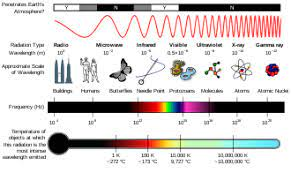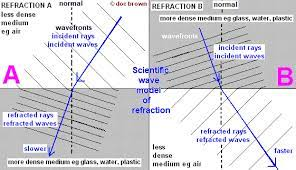
Electromagnetic Waves and Refraction
There’s a continuous spectrum of EM waves
All EM waves are transverse waves that transfer energy from a source to an absorber
All EM waves travel at the same speed through air or a vacuum
Electromagnetic waves form a continuous spectrum over a range of frequencies. They are grouped into seven basic types, based onto their wavelengths and frequency

There is such a large range of frequencies because EM waves are generated by a variety of changes in atoms and their nuclei. This also explains why atoms can absorb a range of frequencies-each one causes a different change
Because of their different properties, different EM waves are used for different purposes
Refraction- waves changing direction at a boundary
When a wave crosses a boundary between materials at an angle it changes direction - it’s refracted
How much it’s refracted by depends on how much the wave speeds up or slows down, which usually depends on the density of the two materials. If a wave crosses a boundary and slows down it will bend towards the normal, if it crosses into a material and speeds up it will bend away from the normal
The wavelength of a wave changes when it is refracted, but the frequency stays the same
If the wave is travelling along the normal it will change speed, but it’s NOT refracted

The optical density of a material is a measure of how quickly light can travel through it-the higher the optical density, the slower light waves travel through it
You can construct a ray diagram for a refracted light ray
First, start by drawing the boundary between your two materials and the normal
Draw an incident ray that meets the normal at the boundary. The angle between the rau and the normal is the angle of incidence
Now draw the refracted ray on the other side of the boundary. If the second material is optically denser than first, the refracted ray bend towards the normal. The angle between the refracted ray and the normal is smaller than the angle of incidence. If the second material is less optically dense, the angle of refraction is larger than the angle of incidence
Electromagnetic Waves and Refraction
There’s a continuous spectrum of EM waves
All EM waves are transverse waves that transfer energy from a source to an absorber
All EM waves travel at the same speed through air or a vacuum
Electromagnetic waves form a continuous spectrum over a range of frequencies. They are grouped into seven basic types, based onto their wavelengths and frequency

There is such a large range of frequencies because EM waves are generated by a variety of changes in atoms and their nuclei. This also explains why atoms can absorb a range of frequencies-each one causes a different change
Because of their different properties, different EM waves are used for different purposes
Refraction- waves changing direction at a boundary
When a wave crosses a boundary between materials at an angle it changes direction - it’s refracted
How much it’s refracted by depends on how much the wave speeds up or slows down, which usually depends on the density of the two materials. If a wave crosses a boundary and slows down it will bend towards the normal, if it crosses into a material and speeds up it will bend away from the normal
The wavelength of a wave changes when it is refracted, but the frequency stays the same
If the wave is travelling along the normal it will change speed, but it’s NOT refracted

The optical density of a material is a measure of how quickly light can travel through it-the higher the optical density, the slower light waves travel through it
You can construct a ray diagram for a refracted light ray
First, start by drawing the boundary between your two materials and the normal
Draw an incident ray that meets the normal at the boundary. The angle between the rau and the normal is the angle of incidence
Now draw the refracted ray on the other side of the boundary. If the second material is optically denser than first, the refracted ray bend towards the normal. The angle between the refracted ray and the normal is smaller than the angle of incidence. If the second material is less optically dense, the angle of refraction is larger than the angle of incidence
 Knowt
Knowt
